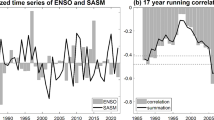Abstract
The relationship between El-Niño/Southern Oscillation (ENSO) and the Indian monsoon is analyzed using cross-wavelet analysis and Granger causality estimation from empirical data for the period 1871-2003. In addition to the previously known negative correlation between the processes analyzed, their bidirectional coupling is detected and characteristics of its inertia and nonlinearity are estimated. The results from an analysis of variations in coupling characteristics in a moving window with a width ranging from 10 to 100 years demonstrate an alternation of different regimes of processes interaction, including intervals of almost unidirectional coupling.
Similar content being viewed by others
References
Climate Change 2007: The Physical Science Basis, Ed. by S. Solomon, D. Qin, M. Manning, et al., (Cambridge University Press, Cambridge, 2007).
T. Zhou, L. Zhang, and H. Li, “Changes in Global Land Monsoon Area and Total Rainfall Accumulation over the Last Half Century,” Geophys. Rev. Lett. 35, L16707 (2008). doi: 10.1029/2008GL034881
E. W. Bliss and G. T. Walker, “World Weather V,” Mem. R. Meteorol. Soc. 4(36), 53–84 (1932).
R. H. Kripalani and A. Kulkarni, “Rainfall Variability over Southeast Asia: Connections with Indian Monsoon and ENSO Extremes: New Perspectives,” Int. J. Climatol. 17(11), 1155–1168 (1997).
K. K. Kumar, B. Rajagopalan, and A. M. Cane, “On the Weakening Relationship between the Indian Monsoon and ENSO,” Science 284(5423), 2156–2159 (1999).
V. Krishnamurthy and B. N. Goswami, “Indian Monsoon-ENSO Relationship on Interdecadal Timescale,” J. Clim. 13(3), 579–595 (2000).
R. H. Kripalani and A. Kulkarni, “Monsoon Rainfall Variations and Teleconnections over South and East Asia,” Int. J. Climatol. 21(5), 603–616 (2001).
S. Sarkar, R. P. Singh, and M. Kafatos, “Further Evidences for the Weakening Relationship of Indian Rainfall and ENSO over India,” Geophys. Rev. Lett. 31, L13209 (2004). doi: 10.1029/2004GL020259
D. Maraun and J. Kurths, “Epochs of Phase Coherence between El Nino/Southern Oscillation and Indian Monsoon,” Geophys. Rev. Lett. 32, L15709 (2005). doi: 10.1029/2005GL023225
L. Zubair and C. F. Ropelewski, “The Strengthening Relationship between ENSO and Northeast Monsoon Rainfall Over Sri Lanka and Southern India,” J. Clim. 19(8), 1567–1575 (2006).
S.-Y. Yim, J. -G. Jhun, and S. -W. Yeh, “Decadal Change in the Relationship between East Asian-Western North Pacific Summer Monsoons and ENSO in the Mid-1990s,” Geophys. Rev. Lett. 35, L20711 (2008). doi: 10.1029/2008GL035751
S. Jevrejeva, J. C. Moore, and A. Grinsted, “Influence of the Arctic Oscillation and El Nino-Southern Oscillation (ENSO) on Ice Conditions in the Baltic Sea: The Wavelet Approach,” J. Geophys. Res. 108(D21), 4677 (2003). doi: 10.1029/2003jd003417
C. W. J. Granger, “Investigating Causal Relations by Econometric Models and Cross-Spectral Methods,” Econometrica 37(3), 424–438 (1969).
N. Ancona, D. Marinazzo, and S. Stramaglia, “Radial Basis Function Approach to Nonlinear Granger Causality of Time Series,” Phys. Rev. E 70 056221 (2004). doi: 10.1103/PhysRevE.70.056221
U. Feldmann and J. Bhattacharya, “Predictability Improvement as an Asymmetrical Measure of Interdependence in Bivariate Time Series,” Int. J. Bifurc. Chaos 14(2), 505–514 (2004).
K. Ishiguro, N. Otsu, M. Lungarella, et al., “Detecting Direction of Causal Interactions Between Dynamically Coupled Signals,” Phys. Rev. E: 77(3), 026216 (2008).
W. Wang, B. T. Anderson, R. K. Kaufmann, et al., “The Relation between the North Atlantic Oscillation and SSTs in North Atlantic Basin,” J. Clim. 17(24), 47524759 (2004).
I. I. Mokhov and D. A. Smirnov, “El-Niño-Southern Oscillation Drives North Atlantic Oscillation as Revealed with Nonlinear Technique from Climatic Indices,” Geophys. Rev. Lett. 33, L03708 (2006a). doi: 10.1029/2005GL024557
I. I. Mokhov and D. A. Smirnov, “Study of the Mutual Influence of the El-Niño-Southern Oscillation Processes and the North Atlantic and Arctic Oscillations,” Izv. Atmos. Okean. Phys. 42(5), 598–614 (2006).
T. J. Mosedale, D. B. Stephenson, M. Collins, et al., “Granger Causality of Coupled Climate Processes: Ocean Feedback on the North Atlantic Oscillation,” J. Clim. 19(7), 1182–1194 (2006).
I. I. Mokhov and D. A. Smirnov, “Diagnostics of a Cause-Effect Relation between Solar Activity and the Earth’s Global Surface Temperature,” Izv. Atmos. Okean. Phys. 44(3), 263–272 (2008).
I. I. Mokhov, D. A. Smirnov, P. I. Nakonechny, et al., “Assessment of the Mutual Effect of El-Niño-Southern Oscillation and Indian Monsoon,” in Modern Problems of Oceanic and Atmospheric Dynamics, Ed. by A. V. Frolov and Yu. D. Resnyanskii (Triada LTD, Moscow, 2010), pp. 251–267 [in Russian].
I. I. Mokhov, D. A. Smirnov, P. I. Nakonechny, et al., “Alternating Mutual Influence of El-Niño/Southern Oscillation and Indian Monsoon,” Geophys. Rev. Lett. (2010). doi: 10.1029/2010Gl045932
N. A. Rayner, D. E. Parker, E. B. Horton, et al., “Global Analyses of Sea Surface Temperature, Sea Ice, and Night Marine Air Temperature since the Late Nineteenth Century,” J. Geophys. Res. 108(D14) (2003). doi: 10.1029/2002Jd002670
R. W. Reynolds and T. M. Smith, “Improved Global Sea Surface Temperature Analyses,” J. Clim. 7(6), 929–948 (1994).
D. A. Mooley and B. Parthasarathy, “Fluctuations in All-India Summer Monsoon Rainfall during 1871–1978,” Clim. Change 6(3), 287–301 (1984).
C. Torrence and G. P. Compo, “A Practical Guide to Wavelet Analysis,” Bull. Am. Meteorol. Soc. 79(1), 61–78 (1998).
M. S. Bartlett, An Introduction to Stochastic Processes (Cambridge Univ. Press, Cambridge, 1978).
G. A. F. Seber, Linear Regression Analysis (Wiley, New York, 1977).
G. Schwartz, “Estimating the Dimension of a Model,” Ann. Stat. 6(2), 461–464 (1978).
A. Pikovsky, M. Rosenblum, and J. Kurths, Synchronization. A Universal Concept in Nonlinear Sciences (Gambridge Univ. Press, Cambridge, 2001).
Author information
Authors and Affiliations
Corresponding author
Additional information
Original Russian Text © I.I. Mokhov, D.A. Smirnov, P.I. Nakonechny, S.S. Kozlenko, J. Kurths, 2012, published in Izvestiya AN. Fizika Atmosfery i Okeana, 2012, Vol. 48, No. 1, pp. 56–66.
Rights and permissions
About this article
Cite this article
Mokhov, I.I., Smirnov, D.A., Nakonechny, P.I. et al. Relationship between El-Niño/Southern Oscillation and the Indian monsoon. Izv. Atmos. Ocean. Phys. 48, 47–56 (2012). https://doi.org/10.1134/S0001433812010082
Received:
Published:
Issue Date:
DOI: https://doi.org/10.1134/S0001433812010082




